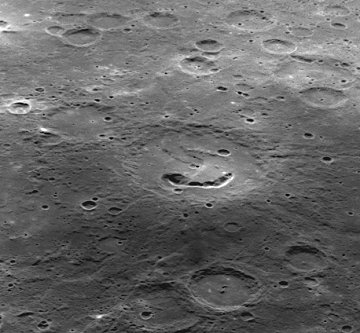| COSMIC RAYS HIT SPACE AGE HIGH: NASA spacecraft are measuring record-high levels of cosmic rays--a side-effect of the deepest solar minimum in nearly a century. This development could have implications for the amount of shielding astronauts need to take when they explore deep space. Science@NASA has the full story. MERCURY FLYBY: NASA's MESSENGER spacecraft is receding from Mercury after a Sept 29th flyby that put smiles on the faces of mission scientists. MESSENGER is beaming back images of thousands of square miles of previously unseen terrain, including this cheerful crater: 
The arc-shaped depression in the crater's floor is a "pit crater." A few of these have been seen on Mercury, and they are probably volcanic in nature. Pit craters may have formed when subsurface magma drained away and left a roof area unsupported, leading to collapse and the formation of the pit. In this example, the southern area of the pit appears to have two or more floor levels. The discovery of multiple pit-floor craters adds to a growing body of evidence that volcanic activity was widespread in Mercury's past. Stay tuned for more happy discoveries. THE OPTICS OF DANDELIONS: Beautiful displays of atmospheric optics usually require some form of clouds, snow or rain. Ice and clouds are not required, however, when you have a dandelion handy: 
"Autumn is here and many flowers are preparing for the next generation with hairy seed pods," says photographer Monika Landy-Gyebnar of Veszprem, Hungary. "If you hold these seeds against the light and look through their tiny hairs, you can see a very colourful little world! It is a real do-it-yourself optics phenomenon!" Atmospheric optics expert Les Cowley explains the physics: "Light waves bend (diffract) around obstacles in their way. The waves from each side of a tiny hair combine together downstream to make a colorful interference pattern. The shining iridescent hues of dandelion seed hairs, spider webs and clouds of small water droplets are all a result of this process." Landy-Gyebnar has one final suggestion: "After examining the colors of a sunlit dandelion or aster, you can help them spread by blowing on them." Then it really is atmospheric optics.
Sept. 2009 Aurora Gallery
[previous Septembers: 2008, 2007, 2006, 2005, 2004, 2002, 2001]
Explore the Sunspot Cycle | 
